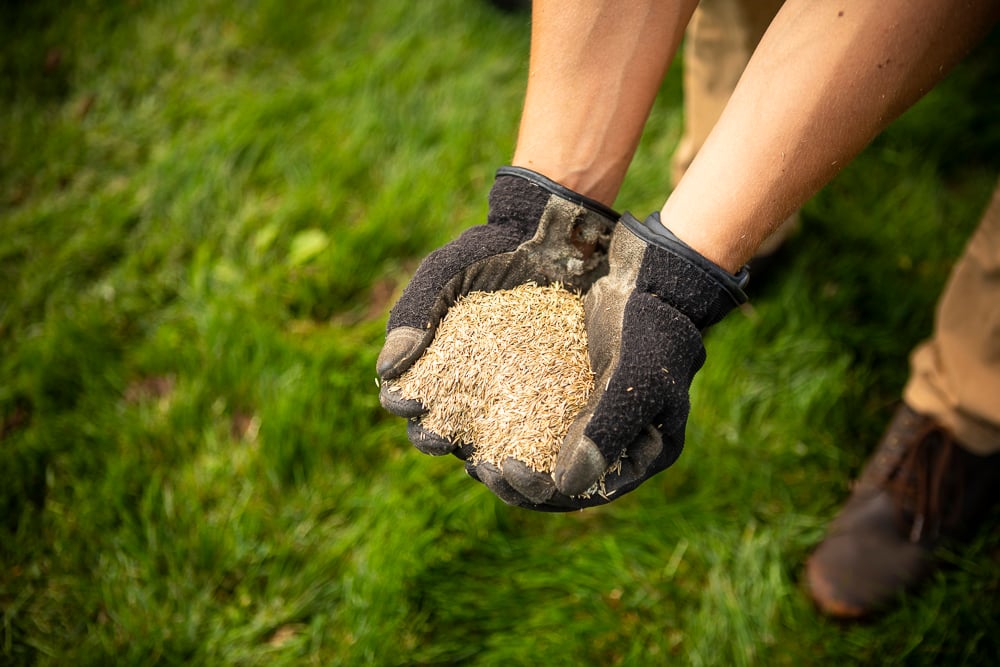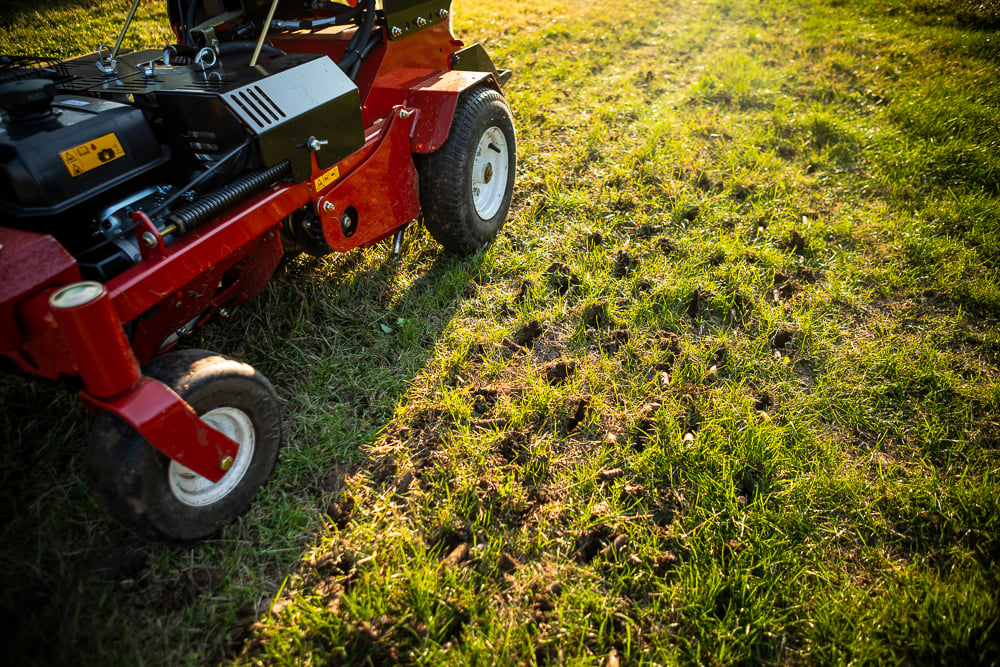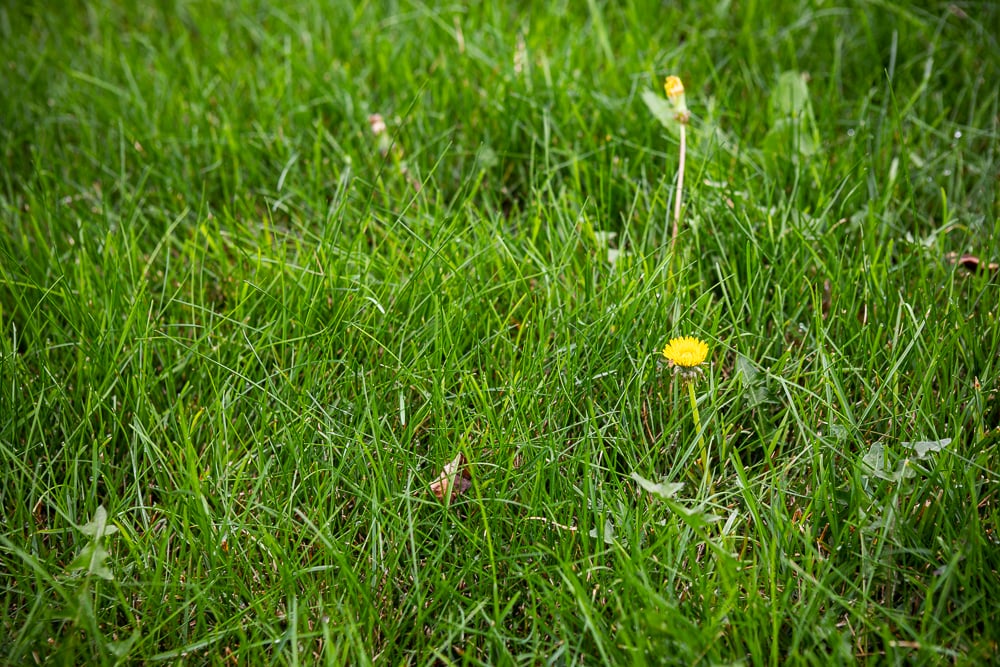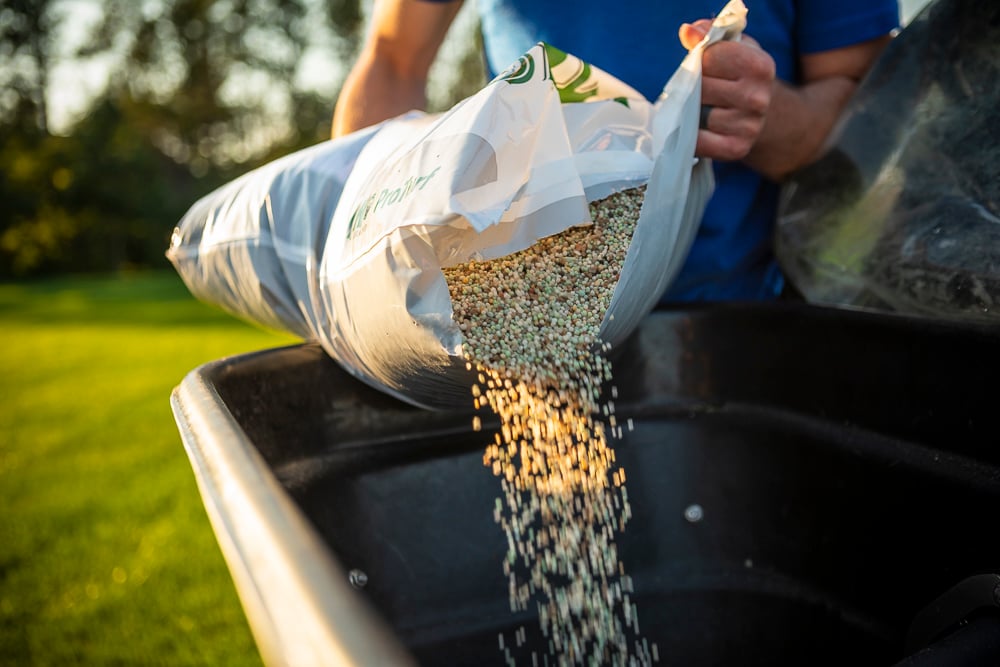When it comes to repairs around the house, your trusty hammer and screwdriver won’t always come to the rescue.
Lawn repairs need their own set of tools.
Jump to Section
- What Is the Best Way to Repair a Lawn?
- Lawn Repair Tips for a Patchy Lawn
- How to Fix My Lawn in Spring?
- Lawn Repair: How to Fix a Dead Lawn
- How to Fix My Existing Lawn If It’s Full of Weeds?
- Lawn Repair: How Your Soil pH Plays a Part
- How to Restore a Poor Lawn? Feed It with Fertilizer
- Lawn Repair: You Might Need New Soil
What is the best way to repair a lawn? Just as when you’re sick, the repair depends on the symptoms. Grass seed might do the trick, or your lawn might need aeration. A strong weed killer could be your solution, or a solid fertilizer plan might be necessary.
Remember when you had the flu and were a real mess? Your lawn might need all of these solutions to get healthy again.
Keep reading to learn more lawn-repair tips that actually work.
What Is the Best Way to Repair a Lawn?
It depends on exactly what’s going on out there.
Maybe you have a few dead spots leftover from lawn disease or dog urine. Or maybe the whole thing is patchy, no matter what you do. Are there more weeds than grass? Does it never quite green up the way your neighbors’ lawns do?
-1.jpg?width=1200&height=900&name=bare%20spots%20in%20lawn%201%20(1)-1.jpg)
Depending on why your grass is suffering, there are specific ways to target lawn repair.
How can a poor lawn be restored? Depending on the problem, let’s explore some expert lawn care tips.
1. Lawn Repair Tips for a Patchy Lawn
Lawn care in Eau Claire, WI, almost always includes reviving a patchy lawn.
Every homeowner faces a few bare spots once in a while. A proper seeding with quality grass seed can often do the trick to fix a patchy lawn. Are you new to seeding? Check out these helpful tips:
First, rake out any dead, matted turf. Your grass seed will germinate and root best if it can snuggle up to bare soil.
Dig and loosen the soil a bit to prepare it for the seed.
Scatter grass seed over the loosened soil, scratching and tamping it to ensure good contact.
Add some fertilizer designed for new grass to get it off to a good start.
Keep it watered.
Be patient. It will take about a month for your new seed to start growing and up to a year to become fully mature grass.
Grass seed pro tip: This isn’t the time to ask how to fix a lawn on a budget. Please don’t be tempted by that cheap bag of grass seed. Yes, grass seed of all sorts of looks the same. But it isn’t.
You daydream about a thick carpet of green grass, right? That’s not what you’ll get from that bag of cheap grass seed at the home improvement store. It may contain weed seeds and undesirable grasses.
It’s worth it to pay more for premium grass seed.
2. How to Fix My Lawn in Spring?
Spring is supposed to be a happy time of rebirth, when the gray, winter Wisconsin landscape springs to life in spectacular shades of green.
Hmmm. Better remind your lawn.

The steel snow plow blades that cleared the piles of white stuff likely left some gouges. And those ice melt products that kept your flat surfaces clear of treacherous ice may have done some damage, too.
Winter can be tough on your lawn.
What’s the best way to repair a lawn damaged from winter?
Too much ice melt can damage your lawn with salt burn. Some areas might be dead, so you’ll need to re-select those damaged lawn areas.
Your grass might grow back after snow plow damage — it depends on the extent of the damage. If the plow only slightly disturbs your grass, it will probably recover on its own.
But if those plow blades did a number on your lawn, scraping up big sections of turf, you’ll likely need to re-seed after snow removal damage.
3. Lawn Repair: How to Fix a Dead Lawn
So, you think your lawn is dead? You’ve already started the organ music? Not so fast.
It’s rare that your whole lawn is dead. There are times that drought or disease or a hard winter might kill areas, though, and you end up with unsightly dead patches.
Here's a quick way to tell if your grass is dead or just dormant: Grab hold of a couple of clumps of grass and tug. Does it pull right up with no root system holding it in? It’s probably dead. But a dormant lawn will still have a solid root system and some resistance.
If your lawn isn’t dead but looks bad, aeration and seeding can be your best friends in lawn repair.

It’s possible your lawn can’t breathe.
When the soil becomes compacted, the lawn gasps for air. Its roots can't take in water or nutrients, which weakens the turf and invites disease and weeds.
Lawn aeration uses a machine to pull out plugs of soil, creating spaces for air and water to penetrate, which leads to healthier roots.
Lawn aeration also helps break down thatch, the layer of dead grass and stems between the grass blades and the soil.
Aeration is usually followed by overseeding, as the holes created are perfect new homes for the grass seed.
How to restore a poor lawn? Good aeration and seeding can do wonders for a struggling lawn.
4. How to Fix My Existing Lawn If It’s Full of Weeds?
First up: what kind of weeds? Different weeds call for different plans of attack, and we have quite a few weed villains here in Wisconsin.
Lawn care in Eau Claire, WI, includes targeted weed control, but there’s no one weed-killing product that kills all weeds. That would be too easy, right?
Crabgrass is the king of weeds. It is an annual weed that spreads fast, quickly takes over your lawn, and makes it look terrible. Even worse, it can kill off other grass varieties and steal important nutrients, such as nitrogen, which your lawn needs.

Among the top lawn care tips? Stay ahead of crabgrass.
When it comes to killing crabgrass, timing is everything. You need pre-emergent weed control — targeting the seeds as they germinate and take root in the soil to prevent them from sprouting in the first place. This needs to happen in early spring.
If you wait until crabgrass shows up, you’ll have a much tougher time getting rid of it.
And crabgrass isn’t the only weed out there trying to take over your Eau Claire lawn.
We target dastardly dandelions with a specialty “weed shield” herbicide designed to reduce the number of emerging dandelions. If any sneak through, we can treat them with a broadleaf herbicide at any time of year.
To combat Creeping Charlie, a tenacious perennial, we use a professional-grade, specialty weed killer multiple times throughout the year.

You’ll notice the term “professional grade.” That’s important. Your typical home improvement store weed control won’t do the job.
Let the pros tackle your lawn’s toughest weeds with quality products and targeted strategies to kick weeds to the curb.
5. Lawn Repair: How Your Soil pH Plays a Part
No matter what kind of shape your lawn is in, it’s always good idea to test your soil pH.
Why does lawn soil pH matter? Important nutrients for plants tend to be available in the soil when the pH is at the correct level. If your pH is off, your grass won’t get the nutrients it needs, even if you fertilize regularly. It’s pretty frustrating.
Soil pH is a way to measure the amount of acidity or alkalinity in your lawn’s soil.
It’s measured on a scale from 0 to 14. Extreme acidity is at the low end of the scale, and extreme alkalinity is at the top.
The soil at the midpoint, number 7, is neutral—neither acidic nor alkaline. Most grasses thrive at a pH range of between 6.0 and 7.0.
That’s the goal — a perfect balance.
A pro lawn care tip you don’t always hear about is having your soil’s pH level tested. If it’s out of whack, we can add the right soil amendments to restore it to its original level.
6. How to Restore a Poor Lawn? Feed It with Fertilizer
Like you at about 3 pm every day, your lawn can’t thrive if it’s hungry.
A good fertilizer program can help bring your lawn back to life. It’s your lawn’s food, and it’s super important.
Always opt for granular lawn fertilizer. It’s more expensive than the more common liquid stuff, so it adds a bit to lawn repair cost, but it breaks down slowly, giving you consistent benefits from fertilization.

Ideally, it will also contain organic nutrients to promote healthy soil, too.
Looking for lawn care services in Eau Claire, WI? You’ll get professional-grade organic-based formulations of granular fertilizer with RainMaster.
7. Lawn Repair: You Might Need New Soil
The soil beneath your lawn doesn’t get much credit, but it’s a silent superstar — the foundation for healthy grass. It’s where your lawn gets the nutrients it needs to grow.
When it’s healthy, soil is full of good stuff you can’t see, but your lawn loves, from wriggly worms to fungi to nutrient-rich microbes that nourish it.
We often have sandy soil here in Eau Claire. That’s not good. It means water and nutrients run right through it.
You can boost your lawn’s soil by adding nutrients like compost. Leaving your grass clippings helps, too. Don’t bag them. They’ll break down into tasty nutritious bits that enrich the soil.
You might need new soil if these soil-boosting lawn repair strategies aren’t working.
Consider hiring a landscaping company to dig out the sand and add good black soil to help your lawn thrive.
Need Lawn Repair in Eau Claire, WI? Trust RainMaster Lawn
Once you’ve figured out the right lawn repair, yay! But lawn repair is just the beginning. Your grass needs you to be in this for the long haul.
How can a poor lawn be restored? Invest in a proactive lawn care program to continuously improve and protect your lawn.
Thinking of tackling your Eau Claire lawn care on your own? Don’t you have better things to do than spend your weekends trying to repair bare lawn spots or fix a lawn full of weeds?

We’re happy to inspect your lawn and suggest the right course of action to get it in shape.
Consider it a team effort. Let’s create a custom nutrition plan for your lawn so the roots will be nourished, the soil packed with nutrients, and your grass so thick and healthy that lawn weeds will have a tough fight ahead.
We offer three levels of lawn care programs, depending on your desired results, how fast you want to see results, and your budget.
When you’re ready to trust us, we can’t wait to meet you and help you make the best choices for your lawn.
Want to fix your lawn once and for all? Request a quote today! We’ll review your lawn care options together so you can make a great choice. Then, you can finally enjoy your lawn and stop worrying about it.




